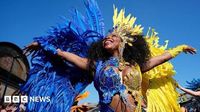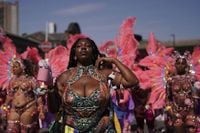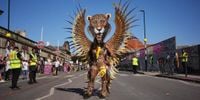The streets of west London have once again come alive with the vibrant colors, infectious rhythms, and unmistakable energy of the Notting Hill Carnival, as Europe’s largest street party drew to a close on Monday, August 25, 2025. After more than half a century of tradition, this year’s event continued to celebrate the rich tapestry of Caribbean culture and history, bringing together millions for a spectacle that is as much about community as it is about festivity.
The festivities kicked off over the weekend, with the Children’s Day Parade and the traditional ‘J’Ouvert’ sunrise celebrations on Sunday, August 24. According to Reuters, young participants donned elaborate Caribbean-themed costumes, dancing and smiling their way through the streets as parents and onlookers cheered them on. The Children’s Day Parade has long been a cherished part of the carnival, providing a platform for the youngest revellers to showcase their heritage and creativity. Early risers were treated to the ‘J’Ouvert’ procession—a joyful, paint-splattered tradition marking the start of the carnival weekend, with music and laughter echoing through the dawn.
By Monday, the energy had reached its peak as the main parade wound its way through Notting Hill’s iconic avenues. BBC London News reported that the numbers attending swelled dramatically, no doubt encouraged by a rare spell of west London sunshine, with temperatures soaring to 26C. The parade featured bejewelled dancers, booming sound systems, the unmistakable clang of steel drums, and the mouthwatering aroma of barbecue wafting through the air. For many, the sights, sounds, and smells of the day lingered long after the last float passed by.
Bands and floats representing the Caribbean, African, and Brazilian diaspora formed the heart of Monday’s procession. According to detailed coverage from The Guardian, groups such as Bajan Raw Licquer, Mahogany, Chocolate Nation, Mas Africa, Vincy Alliance, and United Kreyol brought traditions from Trinidad & Tobago, Barbados, St Lucia, Grenada, Jamaica, Dominica, and Haiti to the streets of London. Brazilian performers from Paraiso Samba School, Batala, and Dende Nation injected their own flair, while long-established UK community bands held their own, ensuring that the parade was a truly global affair.
Participants began arriving early at Westbourne Park Underground station, many already dressed in dazzling, eye-catching costumes. As PA Wire/PA Images noted, the streets quickly filled with color, dancing, and the pulse of music, as the final day of the annual celebration got underway. The Notting Hill Carnival, first held in 1966, has become a cornerstone of London’s cultural calendar, drawing people from across the UK and around the world. As one participant, Maria James, 34, told The Guardian: “It feels like a piece of the Caribbean right here in London.”
That sense of unity and multicultural pride was echoed by James Lewis, 41, who made the journey from Birmingham to attend. “It’s amazing to see so many cultures coming together,” he said, capturing the essence of what the event means to so many.
But the scale of Notting Hill Carnival is not just measured in joy and celebration—it’s also a logistical marvel. The Associated Press reported that the two-day street event attracts around 2 million revellers, musicians, and dancers, making it one of the largest carnivals in the world. To keep festivities running smoothly, approximately 7,000 police officers and staff were on duty each day, ensuring the safety and security of all those attending.
The sheer volume of people means that the clean-up operation is almost as impressive as the event itself. According to The Guardian, Kensington and Chelsea Council cleared an estimated 150 tonnes of rubbish after the first day alone, with a total of 300 tonnes expected to be collected over the weekend. A dedicated crew of 180 staff and 45 vehicles worked through the night, and the clean-up continued on Monday night to prepare the area for the return of normal business on Tuesday morning.
For locals and visitors alike, the carnival is an immersive experience. The soundscape—whistles, horns, steel drums—melds with the visual feast of sequins, feathers, and flags. The air is thick with the scent of jerk chicken and grilled corn, while the energy is palpable, a testament to the enduring spirit of the communities who have shaped the event over the decades.
The Children’s Day Parade, held on Sunday, is a particular highlight for many families. Reuters captured the joy of children in Caribbean-themed costumes, waving, dancing, and embracing their heritage. For these young participants, the parade is more than just a party—it’s a rite of passage, a chance to connect with their roots and share their culture with the wider city.
Monday’s parade brought together an even broader mix of performers and spectators. The inclusion of Brazilian samba groups, African drummers, and UK community bands underscored the carnival’s evolution into a truly international celebration. Yet, at its core, the event remains a tribute to the Caribbean diaspora, honoring the resilience, creativity, and contributions of those who made London their home and transformed its cultural landscape.
Throughout the day, the mood was one of jubilation and pride. The BBC described the event as “Europe’s largest street party,” a title it has earned through decades of growth and adaptation. The event’s roots lie in the struggles and triumphs of Caribbean immigrants in post-war Britain, who used music, dance, and food as a means of asserting their identity and building community in the face of adversity. Today, the carnival stands as a testament to that legacy, bringing together generations in a joyful, defiant celebration of diversity.
As the sun began to set on Monday, the official parade may have wound down, but the party was far from over. Revellers continued to dance, sing, and celebrate late into the afternoon and evening, determined to make the most of every last moment. For those lucky enough to attend, the memories—of music, color, camaraderie—will linger long after the streets have been swept clean and the costumes packed away.
With another successful year in the books, the Notting Hill Carnival remains a shining example of how tradition, community, and creativity can come together to create something truly extraordinary in the heart of London.



